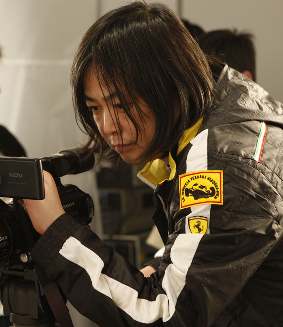 | Born in 1971 in (China) Lives and works in (China ) | Biographie Bibliographie Liste expositions |
 | Born in 1971 in (China) Lives and works in (China ) | Biographie Bibliographie Liste expositions |
Born in Beijing in 1971, Yang Fudong graduated in 1995 from the Fine Arts Institute of Hangzhou, where he acquired training as a painter and an initiation to contemporary art, before dedicating himself to photography, video and film. Hangzhou is celebrated for its beauty; it is traditionally known as the city of artists. This was where he shot his first film, making reference in his compositions to traditional Chinese painting. An Estranged Paradise was shot in 35 mm in black and white, over five years, from 1997 to 2002, owing to editing difficulties and Fudong's reticence to show the work. A work of youth, it evokes the problems of his generation. The hero Zhuzi relates his existential melancholy in the city of Hangzhou, which has been compared to heaven and praised by poets and painters alike. The scenario evokes the emotional climate among his peers, who, at the end of their studies, are posing questions about their future and expectations. "The protagonist Zhu Zhi, represents precisely this aspect that I saw in my young contemporaries, this incapacity to bring things to resolution, to act, to create something.” (A quote from the artist in the essay "Yang Fudong: the Foreigner and the Search for Poetic Truth" by Marcella Beccaria). This film about the boredom and emptiness of existence may evoke the worlds of Jean-Luc Godard or Jim Jarmusch, but Fudong specifies that he had little access to foreign films at the time, and that the influence is indirect, whereas it is directly linked to Chinese cinema of the 1920s. The relationship between modernity and the Chinese tradition revealed in the urban landscapes reflects the ambiguity of the young people in their relationship to the past and the future, to tradition and modernity. The young people strive to find a balance between their aspirations and the reality of everyday life.
After his studies, Yang Fudong moved to Shanghai, the influential centre of Chinese cinema –especially that of the 1920s and 30s, which particularly interest the artist. He saw many Chinese films, including Spring in a Small Town by Fei Mu (Xiao cheng zhi chun, 1948), a film that continues to influence filmmakers today.
From 1999, his works acquired an international reputation, thanks to the Hannover Film Festival.
His work mainly consists of films and photographs, which he presents in the form of installations. Besides the conflict between tradition and modernity, the question of the intellectual aspirations and frustrations arising from this conflict is a core theme. Does knowledge and education help or hinder one's relationship with society? In the photographic triptych The First Intellectual (2000), a man, by himself, prepares to throw a brick but we do not know at whom or what. His shirt is stained with blood and books spill out of a suitcase onto the pavement. In this suspended movement, the gesture is both futile and full of hope. This intellectual fights against obstacles and doesn't know if they come from himself or from society. Ideals define people by uniting or separating them.
This thematic was already broached in Estranged Paradise and is consciously developed in the series created for the 50th Venice Biennale in 2003, where Yang Fudong presented the first element of a film in 5 parts, Seven Intellectuals in Bamboo Forest (2003-2007), inspired by a traditional folk legend. This story of seven wise men in the Bamboo Forest had long been the subject of paintings commissioned in ancient China. A group of intellectuals fled the conflicts surrounding the transition from the Wei dynasty to the Jin dynasty in the 3rd century. They gather in a bamboo plantation to forget the troubles and savour pure thoughts and discussions, thus fleeing society and taking refuge in the utopia of total individual freedom. Fudong's proposition explores five different situations based on this legend, questioning the individual in society, the past, the present, reality and utopia.
More spectacular, his latest video installation, Fifth Night, is a multi-screen film that was presented for the first time in 2010. Consisting of seven synchronised sequence shots, this film plunges us into a wordless narration, whose suggestive framework escapes us, leaving spectators with an unresolved expectation. The sound and Foley effects attract the eye from one image to the next, as the screening is too monumental to be seen from just one perspective. Each camera posted in 7 corners of the same square in old Shanghai follows one character, then another, considerably complicating our understanding of the location and the dialogue. The use of black and white is very elegant and removes all sense of temporality, in order to focus the gaze on each of the characters' details and expressions as they move about this public space for no apparent reason. Mysterious and refined, the exercise in style that this installation represents anchors Yang Fudong's work a little further within cinematographic aesthetic concerns.
Patricia Maincent